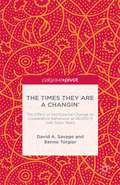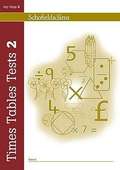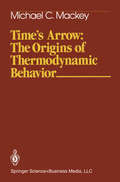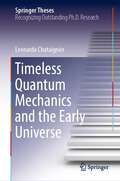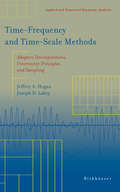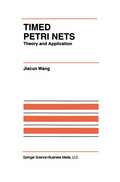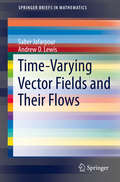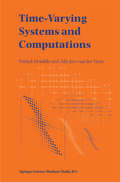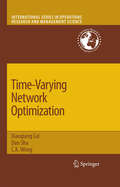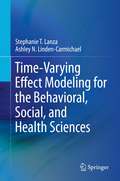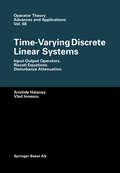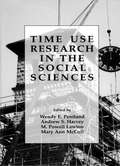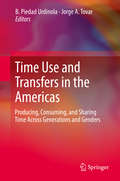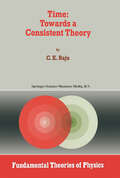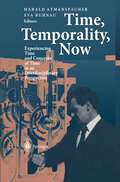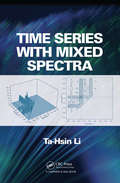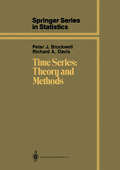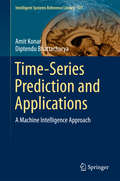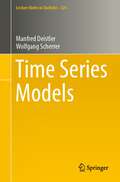- Table View
- List View
The Times They Are A Changin': The Effect of Institutional Change on Cooperative Behaviour at 26,000ft over Sixty Years
by D. Savage B. TorglerThis narrative and empirical analysis investigates Hilary's claim that in his day they would not have left a man behind to die. The authors examine over 60 years of Himalayan climbing data and stories in order to test the changes in cooperation in this extreme life and death environment.
Times tables (UEB uncontracted)
by RnibThese pages show times table grids. It is a multi-page image set on two pages. There is a locator dot shown on each page, which will be at the top left when the image is the correct way up. Times tables The first column is the first multiplier from 1 to 10. The first row is the second multiplier from 1 to 10. Where a row and column meet is the result of the multiplication of the multipliers. For example four in the first column and three in the first row “ go right from the four and down from the three, they meet at twelve which is four times three. Times tables to be learnt This image shows the same grid of numbers as page one but simplified. The easy 2, 5 and 10 tables have been removed. Duplicates are also removed (3 x 4 is the same as 4 x 3). This leaves the fifteen multiplications to be learnt.
Times tables (UEB contracted)
by RnibThese pages show times table grids. It is a multi-page image set on two pages. There is a locator dot shown on each page, which will be at the top left when the image is the correct way up. Times tables The first column is the first multiplier from 1 to 10. The first row is the second multiplier from 1 to 10. Where a row and column meet is the result of the multiplication of the multipliers. For example four in the first column and three in the first row “ go right from the four and down from the three, they meet at twelve which is four times three. Times tables to be learnt This image shows the same grid of numbers as page one but simplified. The easy 2, 5 and 10 tables have been removed. Duplicates are also removed (3 x 4 is the same as 4 x 3). This leaves the fifteen multiplications to be learnt.
Times Tables Tests Up To 12x12: Multiplication Tables Check (PDF)
by Samantha Townsend100 tests to assess fluency and recall of all times tables up to and including 12x12. Get ready for the new multiplication tables check for Year 4 from 2020. Quick tests include variation, problem solving and word problems in context for greater depth and challenge. 30 tests for Year 2; 30 tests for Year 3; and 40 tests for Year 4 all in one book. Times tables are revisited as you progress through the tests. Practise against the clock to improve speed and accuracy with timing suggestions. Photocopy, edit and download. Use in class or set for homework.
Times Tables Tests 2 (PDF)
by Hilary KollTimes Tables Tests provides regular and structured times tables practice, helping children to strengthen their understanding of essential multiplication and division facts. Times Tables Tests 2 covers times tables up to and including 13 x 13 and is suitable for children in Years 4, 5 and 6.
Times Tables Ninja for KS1: Photocopiable multiplication worksheets that support the National Curriculum
by Sarah FarrellThe essential book of times tables activities for the KS1 classroom, perfect for preparing primary pupils to master times tables like a ninja! From Sarah Farrell with Andrew Jennings, the same expert team behind Times Tables Ninja for KS2.The activities in this photocopiable book give Key Stage 1 pupils all the skills needed to gain confidence and fluency in multiplication and division in their 2, 3, 4, 5 and 10 times tables. Times Tables Ninja for KS1 goes above and beyond the National Curriculum to provide a solid foundation ahead of the multiplication tables check in Year 4.Each chapter includes a variety of exercises to promote rapid recall which has been proven to be more effective than learning by rote for early success in maths. The book establishes confidence in one times table at a time, then includes activities to establish that knowledge in the primary maths curriculum to turn all pupils into multiplication Grand Masters!Written by experienced teacher Sarah Farrell (@SarahFarrellKS2) and edited by Andrew Jennings (@VocabularyNinja), this is the ultimate classroom resource for reinforcing times tables and preparing pupils for progression to KS2 maths and beyond.For more must-have Ninja books by Andrew Jennings (@VocabularyNinja), check out Vocabulary Ninja, Arithmetic Ninja, Write Like a Ninja and Comprehension Ninja.
Times Tables Ninja
by Sarah FarrellThe essential book of times tables activities for the primary classroom, perfect for turning all pupils into Grand Masters of Times Tables! From teacher Sarah Farrell and Andrew Jennings, the creator of the bestselling Vocabulary Ninja and Write Like a Ninja.The activities in this photocopiable book gives Key Stage 2 pupils all the tools they need to gain fluency in multiplication and division up to their 12 times tables. Each chapter begins with exercises for practising rapid recall, followed by visually engaging activities for applying knowledge to other areas of maths including shape, perimeter, scale factors, fractions and more.Fully aligned to the primary National Curriculum for maths, Times Tables Ninja features an introduction for teachers explaining the Concrete Pictorial Abstract (CPA) approach and the vocabulary to use when teaching times tables. There are certificates at the end of each section to support progression and encourage children to reach the next Ninja level.Written by experienced teacher Sarah Farrell (@SarahFarrellKS2) and edited by Andrew Jennings (@VocabularyNinja), this is the ultimate classroom resource for reinforcing times tables and preparing pupils for SATS and the statutory multiplication tables check.
Times tables (large print)
by RnibThese pages show times table grids. It is a multi-page image set on two pages. There is a locator dot shown on each page, which will be at the top left when the image is the correct way up. Times tables The first column is the first multiplier from 1 to 10. The first row is the second multiplier from 1 to 10. Where a row and column meet is the result of the multiplication of the multipliers. For example four in the first column and three in the first row “ go right from the four and down from the three, they meet at twelve which is four times three. Times tables to be learnt This image shows the same grid of numbers as page one but simplified. The easy 2, 5 and 10 tables have been removed. Duplicates are also removed (3 x 4 is the same as 4 x 3). This leaves the fifteen multiplications to be learnt.
Time’s Arrow: The Origins of Thermodynamic Behavior (Springer Study Edition)
by Michael C. MackeyThe Second Law of Thermodynamics has been called the most important law of nature: It is the law that gives a direction to processes that is not inherent in the laws of motion, that says the state of the universe is driven to thermal equilibrium. Its mathematical formulation is simple: The entropy of a closed system cannot decrease. Since the recognition that macroscopic phenomena have an atomic basis, it has remained a fundamental problem to reconcile the increase of entropy with the known reversibility of all the laws of microscopic physics. Professor Michael Mackey of McGill University here explores the dynamical basis for the Second Law, that is, he seeks to illuminate the fundamental dynamical properties required for the construction of a successful statistical mechanics. Aimed at physicists and applied mathematicians with an interest in the foundations of statistical mechanics, the book includes such new material as: a demonstration that the black body radiation law can be deduced from maximal entropy principles; a discussion of sufficient conditions for the existence of at least one state of thermodynamic equilibrium; a description of the behavior of entropy in asymptotically periodic systems; a necessary and sufficient condition for the evolution of entropy to a global maximum; and a presen- tation of the three main types of ergodic theorems and their proofs. He also explores the potential role of incomplete knowledge of dynamical variables, measurement imprecision, and the effects of noise in giving rise to entropy increases.
Timeless Quantum Mechanics and the Early Universe (Springer Theses)
by Leonardo ChataignierThe book is based on the author's PhD thesis, which deals with the concept of time in quantum gravity and its relevance for the physics of the early Universe. It presents a consistent and complete new relational formulation of quantum gravity (more specifically, of quantum mechanics models with diffeomorphism invariance), which is applied to potentially observable cosmological effects. The work provides answers to the following questions: How can the dynamics of quantum states of matter and geometry be defined in a diffeomorphism-invariant way? What is the relevant space of physical states and which operators act on it? How are the quantum states related to probabilities in the absence of a preferred time? The answers can provide a further part of the route to constructing a fundamental theory of quantum gravity. The book is well-suited to graduate students as well as professional researchers in the fields of general relativity and gravitation, cosmology, and quantum foundations.
Time‒Frequency and Time‒Scale Methods: Adaptive Decompositions, Uncertainty Principles, and Sampling (Applied and Numerical Harmonic Analysis)
by Jeffrey A. HoganDeveloped in this book are several deep connections between time-frequency (Fourier/Gabor) analysis and time-scale (wavelet) analysis, emphasizing the powerful adaptive methods that emerge when separate techniques from each area are properly assembled in a larger context. While researchers at the forefront of these areas are well aware of the benefits of such a unified approach, there remains a knowledge gap in the larger community of practitioners about the precise strengths and limitations of Fourier/Gabor analysis versus wavelets. This book fills that gap by presenting the interface of time-frequency and time-scale methods as a rich area of work. "Foundations of Time-Frequency and Time-Scale Methods" will be suitable for applied mathematicians and engineers in signal/image processing and communication theory, as well as researchers and students in mathematical analysis, signal analysis, and mathematical physics.
Timed Petri Nets: Theory and Application (The International Series on Discrete Event Dynamic Systems #9)
by Jiacun WangDriven by the request for increased productivity, flexibility, and competitiveness, modern civilization increasingly has created high-performance discrete event dynamic systems (DEDSs). These systems exhibit concurrent, sequential, competitive activities among their components. They are often complex and large in scale, and necessarily flexible and thus highly capital-intensive. Examples of systems are manufacturing systems, communication networks, traffic and logistic systems, and military command and control systems. Modeling and performance evaluation play a vital role in the design and operation of such high-performance DEDSs and thus have received widespread attention from researchers over the past two decades. One methodology resulting from this effort is based on timed Petri nets and related graphical and mathematical tools. The popularity that Petri nets have been gaining in modeling of DEDSs is due to their powerful representational ability of concurrency and synchronization; however these properties of DEDSs cannot be expressed easily in traditional formalisms developed for analysis of `classical' systems with sequential behaviors. This book introduces the theories and applications of timed Petri nets systematically. Moreover, it also presents many practical applications in addition to theoretical developments, together with the latest research results and industrial applications of timed Petri nets. Timed Petri Nets: Theory and Application is intended for use by researchers and practitioners in the area of Discrete Event Dynamic Systems.
Time-Varying Vector Fields and Their Flows (SpringerBriefs in Mathematics)
by Saber Jafarpour Andrew D. LewisThis short book provides a comprehensive and unified treatment of time-varying vector fields under a variety of regularity hypotheses, namely finitely differentiable, Lipschitz, smooth, holomorphic, and real analytic. The presentation of this material in the real analytic setting is new, as is the manner in which the various hypotheses are unified using functional analysis. Indeed, a major contribution of the book is the coherent development of locally convex topologies for the space of real analytic sections of a vector bundle, and the development of this in a manner that relates easily to classically known topologies in, for example, the finitely differentiable and smooth cases. The tools used in this development will be of use to researchers in the area of geometric functional analysis.
Time-Varying Systems and Computations
by Patrick DeWilde Alle-Jan van VeenComplex function theory and linear algebra provide much of the basic mathematics needed by engineers engaged in numerical computations, signal processing or control. The transfer function of a linear time invariant system is a function of the complex vari able s or z and it is analytic in a large part of the complex plane. Many important prop erties of the system for which it is a transfer function are related to its analytic prop erties. On the other hand, engineers often encounter small and large matrices which describe (linear) maps between physically important quantities. In both cases similar mathematical and computational problems occur: operators, be they transfer functions or matrices, have to be simplified, approximated, decomposed and realized. Each field has developed theory and techniques to solve the main common problems encountered. Yet, there is a large, mysterious gap between complex function theory and numerical linear algebra. For example, complex function theory has solved the problem to find analytic functions of minimal complexity and minimal supremum norm that approxi e. g. , as optimal mate given values at strategic points in the complex plane. They serve approximants for a desired behavior of a system to be designed. No similar approxi mation theory for matrices existed until recently, except for the case where the matrix is (very) close to singular.
Time-Varying Network Optimization (International Series in Operations Research & Management Science #103)
by Dan Sha C. K. WongThis text describes a series of models, propositions, and algorithms developed in recent years on time-varying networks. References and discussions on relevant problems and studies that have appeared in the literature are integrated in the book. Its eight chapters consider problems including the shortest path problem, the minimum-spanning tree problem, the maximum flow problem, and many more. The time-varying traveling salesman problem and the Chinese postman problem are presented in a chapter together with the time-varying generalized problem. While these topics are examined within the framework of time-varying networks, each chapter is self-contained so that each can be read – and used – separately.
Time-Varying Effect Modeling for the Behavioral, Social, and Health Sciences
by Stephanie T. Lanza Ashley N. Linden-CarmichaelThis book is the first to introduce applied behavioral, social, and health sciences researchers to a new analytic method, the time-varying effect model (TVEM). It details how TVEM may be used to advance research on developmental and dynamic processes by examining how associations between variables change across time. The book describes how TVEM is a direct and intuitive extension of standard linear regression; whereas standard linear regression coefficients are static estimates that do not change with time, TVEM coefficients are allowed to change as continuous functions of real time, including developmental age, historical time, time of day, days since an event, and so forth.The book introduces readers to new research questions that can be addressed by applying TVEM in their research. Readers gain the practical skills necessary for specifying a wide variety of time-varying effect models, including those with continuous, binary, and count outcomes. The book presents technical details of TVEM estimation and three novel empirical studies focused on developmental questions using TVEM to estimate age-varying effects, historical shifts in behavior and attitudes, and real-time changes across days relative to an event. The volume provides a walkthrough of the process for conducting each of these studies, presenting decisions that were made, and offering sufficient detail so that readers may embark on similar studies in their own research. The book concludes with comments about additional uses of TVEM in applied research as well as software considerations and future directions. Throughout the book, proper interpretation of the output provided by TVEM is emphasized.Time-Varying Effect Modeling for the Behavioral, Social, and Health Sciences is an essential resource for researchers, clinicians/practitioners as well as graduate students in developmental psychology, public health, statistics and methodology for the social, behavioral, developmental, and public health sciences.
Time-Varying Discrete Linear Systems: Input-Output Operators. Riccati Equations. Disturbance Attenuation (Operator Theory: Advances and Applications #68)
by Aristide Halanay Vlad IonescuDiscrete-time systems arise as a matter of course in modelling biological or economic processes. For systems and control theory they are of major importance, particularly in connection with digital control applications. If sampling is performed in order to control periodic processes, almost periodic systems are obtained. This is a strong motivation to investigate the discrete-time systems with time-varying coefficients. This research monograph contains a study of discrete-time nodes, the discrete counterpart of the theory elaborated by Bart, Gohberg and Kaashoek for the continuous case, discrete-time Lyapunov and Riccati equations, discrete-time Hamiltonian systems in connection with input-output operators and associated Hankel and Toeplitz operators. All these tools aim to solve the problems of stabilization and attenuation of disturbances in the framework of H2- and H-control theory. The book is the first of its kind to be devoted to these topics and consists mainly of original, recently obtained results.
Time Use Research in the Social Sciences
by Wendy E. Pentland Andrew S. Harvey M. Powell Lawton Mary Ann McCollThis collection demonstrates the use and variety of applications of time use methodology from multidisciplinary, multinational, and multicultural perspectives. A distinguished roster of contributors from such fields as psychology, occupational therapy, sociology, economics, and architecture examines the complex relationship between human time utilization and health and well-being and evaluates the future of time use analysis as a research tool in the social sciences.
Time Use and Transfers in the Americas: Producing, Consuming, and Sharing Time Across Generations and Genders
by B. Piedad Urdinola Jorge A. TovarThis book provides a comparison of the measurement in time and monetary units of unpaid domestic work in Colombia, Costa Rica, Uruguay, and the Hispanic ethnicity in the United States. A standardized technique allows the development of comparable estimates across countries per age and gender which reveal specific behavioral patterns over the life cycle. A mixture of economic conditions, social norms, and demographic trends provide insightful explanations for the unequal burden that women and girls carry when dealing with unpaid domestic activities, an economically significant but traditionally neglected activity. As such, the book is of interested to practitioners in all social sciences, particularly sociologists, demographers, economists, and policymakers.
Time: Towards a Consistent Theory (Fundamental Theories of Physics #65)
by C.K. RajuIs time, even locally, like the real line? Multiple structures of time, implicit in physics, create a consistency problem. A tilt in the arrow of time is suggested as the most conservative hypothesis which provides approximate consistency within physics and with topology of mundane time. Mathematically, the assumed constancy of the velocity of light (needed to measure time) implies functional differential equations of motion, that have both retarded and advanced deviating arguments with the hypothesis of a tilt. The novel features of such equations lead to a nontrivial structure of time and quantum-mechanical behaviour. The entire argument is embedded in a pedagogical exposition which amplifies, corrects, and questions the conventionally accepted approach. The exposition includes historical details and explains, for instance, why the entropy law is inadequate for time asymmetry, and why notions such as time asymmetry (hence causality) may be conceptually inadequate. The first three parts of the book are especially suited as supplementary reading material for undergraduate and graduate students and teachers of physics. The new ideas are addressed to researchers in physics and philosophy of science concerned with relativity and the interpretation of quantum mechanics.
Time, Temporality, Now: Experiencing Time and Concepts of Time in an Interdisciplinary Perspective
by Harald Atmanspacher Eva RuhnauThe essays in this topical volume inquire into one of the most fundamental issues of philosophy and of the cognitive and natural sciences: the riddle of time. The central feature is the tension between the experience and the conceptualization of time, reflecting an apparently unavoidable antinomy of subjective first-person accounts and objective traditional science. Is time based in the physics of inanimate matter, or does it originate in the operation of our minds? Is it essential for the constitution of reality, or is it just an illusion? Issues of time, temporality, and nowness are paradigms for interdisciplinary work in many contemporary fields of research. The authors of this volume discuss profoundly the mutual relationships and inspiring perspectives. They address a general audience.
Time Series with Mixed Spectra
by Ta-Hsin LiTime series with mixed spectra are characterized by hidden periodic components buried in random noise. Despite strong interest in the statistical and signal processing communities, no book offers a comprehensive and up-to-date treatment of the subject. Filling this void, Time Series with Mixed Spectra focuses on the methods and theory for the stati
Time Series: Theory and Methods (Springer Series in Statistics)
by Peter J. Brockwell Richard A. DavisWe have attempted in this book to give a systematic account of linear time series models and their application to the modelling and prediction of data collected sequentially in time. The aim is to provide specific techniques for handling data and at the same time to provide a thorough understanding of the mathematical basis for the techniques. Both time and frequency domain methods are discussed but the book is written in such a way that either approach could be emphasized. The book is intended to be a text for graduate students in statistics, mathematics, engineering, and the natural or social sciences. It has been used both at the M. S. level, emphasizing the more practical aspects of modelling, and at the Ph. D. level, where the detailed mathematical derivations of the deeper results can be included. Distinctive features of the book are the extensive use of elementary Hilbert space methods and recursive prediction techniques based on innovations, use of the exact Gaussian likelihood and AIC for inference, a thorough treatment of the asymptotic behavior of the maximum likelihood estimators of the coefficients of univariate ARMA models, extensive illustrations of the tech niques by means of numerical examples, and a large number of problems for the reader. The companion diskette contains programs written for the IBM PC, which can be used to apply the methods described in the text.
Time-Series Prediction and Applications: A Machine Intelligence Approach (Intelligent Systems Reference Library #127)
by Amit Konar Diptendu BhattacharyaThis book presents machine learning and type-2 fuzzy sets for the prediction of time-series with a particular focus on business forecasting applications. It also proposes new uncertainty management techniques in an economic time-series using type-2 fuzzy sets for prediction of the time-series at a given time point from its preceding value in fluctuating business environments. It employs machine learning to determine repetitively occurring similar structural patterns in the time-series and uses stochastic automaton to predict the most probabilistic structure at a given partition of the time-series. Such predictions help in determining probabilistic moves in a stock index time-series Primarily written for graduate students and researchers in computer science, the book is equally useful for researchers/professionals in business intelligence and stock index prediction. A background of undergraduate level mathematics is presumed, although not mandatory, for most of the sections. Exercises with tips are provided at the end of each chapter to the readers’ ability and understanding of the topics covered.
Time Series Models (Lecture Notes in Statistics #224)
by Manfred Deistler Wolfgang ScherrerThis textbook provides a self-contained presentation of the theory and models of time series analysis. Putting an emphasis on weakly stationary processes and linear dynamic models, it describes the basic concepts, ideas, methods and results in a mathematically well-founded form and includes numerous examples and exercises. The first part presents the theory of weakly stationary processes in time and frequency domain, including prediction and filtering. The second part deals with multivariate AR, ARMA and state space models, which are the most important model classes for stationary processes, and addresses the structure of AR, ARMA and state space systems, Yule-Walker equations, factorization of rational spectral densities and Kalman filtering. Finally, there is a discussion of Granger causality, linear dynamic factor models and (G)ARCH models. The book provides a solid basis for advanced mathematics students and researchers in fields such as data-driven modeling, forecasting and filtering, which are important in statistics, control engineering, financial mathematics, econometrics and signal processing, among other subjects.
